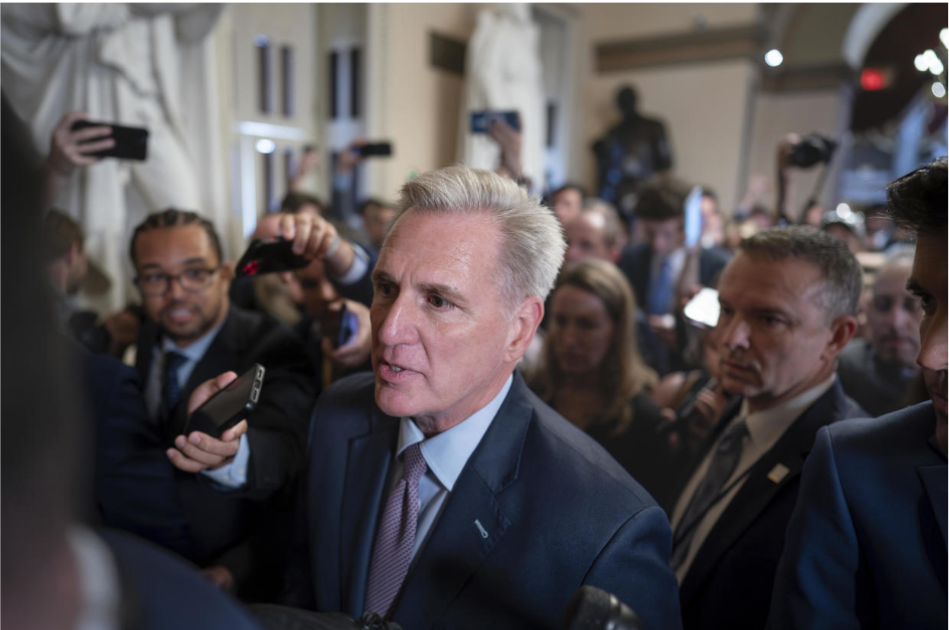U.S. House Speakership Vacant, Legislative Branch Paralyzed

On Tuesday, October 3rd, United States House Speaker Kevin McCarthy, the leader of the Republican majority in the House, was ousted in a 216-210 vote on a “motion to vacate” in which 8 of his fellow Republicans joined all Democrats, the minority, to vote in favor of his removal.
In the weeks since his removal Republicans have nominated Steve Scalise to replace McCarthy, who failed to gain support and withdrew, followed by Jim Jordan, who failed to gain a majority of the House in three successive ballots and was booted by the Republican conference on Thursday.
Republican Patrick McHenry has been serving as Speaker pro tempore but only has the power to preside over votes to elect an official Speaker.
The House has now been without an official Speaker for the longest period in American history. Without a Speaker, the legislative branch is effectively paralyzed since no bills can be introduced and passed on to the Senate or President and become law.
Background
Before being elected Speaker, Kevin McCarthy had been a member of Congress since 2007, and leader of the House Republican Conference since 2019. In that role, he served as the House Minority Leader in opposition to the Democratic majority led by Speaker Nancy Pelosi. Popular among Republicans, he was known for his ability to bridge the different wings within the Republican party, courting both moderates and the far right.
After Republicans gained the majority in the House by a razor thin margin of 4 seats in the 2022 midterm election (218 seats out of 435 makes a majority; currently Republicans have 222 seats and Democrats have 213), McCarthy was elected Speaker in an unprecedented 15 attempts.
McCarthy’s primary stumbling block to power was the refusal of hard right Republicans in the Freedom Caucus to support him. Ultimately, he was only able to scrape together enough votes by making major concessions to the Freedom Caucus, including a promise to make substantial spending cuts, appoint them to valuable leadership positions, and most importantly, allowing any single member of the House to bring forward a “motion to vacate,” that is, the very procedure that was just used to oust him last week.
Considering McCarthy agreeing to allow a single member to bring forward a vote to oust him, many commentators predicted that McCarthy would not last long.
What Happened
McCarthy’s 9 month tenure came to an end following the passage of a bill in early October that prevented the government from shutting down. With only hours before the government was due to shut down, surprised House members were left scrambling to read the bill and decide whether or not to vote for it. Ultimately more Democrats voted for the bill than Republicans—enraging ultra-conservative Republicans forming a group in the House known as the Freedom Caucus, who accused McCarthy of deceiving them.
One of these hard right Republicans was controversial firebrand Matt Gaetz, a staunch ally of Donald Trump and one of the Freedom Caucus’ most high-profile members. Gaetz announced the same day he would be introducing a motion to remove McCarthy.
Four days later, he followed through. Despite McCarthy allies’ attempts to shut down the effort by filing a motion to dismiss the bill, 11 Republicans voted with Democrats to reject the motion, allowing the motion to vacate to proceed.
The final vote to officially oust McCarthy passed with the help of 8 Republicans who chose to vote against their own Speaker, most of whom were Freedom Caucus members like Gaetz.
Aftermath
In the aftermath of McCarthy’s ouster, internal tensions within the Republican Party were further exacerbated. Two main candidates to succeed him emerged—House Majority Leader Steve Scalise, the second highest ranking Republican before McCarthy’s ousting, and Judiciary committee chairman Jim Jordan, a founding member of the Freedom Caucus and one of its most senior members with a reputation for “legislative terrorism.”
Republicans initially voted to nominate Scalise over Jordan, but after the same hard right Republicans who ousted McCarthy refused to support him, he withdrew, leaving Jordan as the only major candidate remaining.
Jordan was swiftly nominated but notably a large portion of the Republican conference was still opposed to him. Jordan’s supporters then began a pressure campaign on the Republican holdouts who refused to support him. The approach may have backfired, however, as when a Speakership election was held on Tuesday, 20 Republicans voted against Jordan. In subsequent votes on Wednesday and Thursday, he lost even more support, with 22 and finally 25 Republicans voting against. This marked the end of Jordan’s speaker campaign. On Thursday, the Republican conference voted to withdraw Jordan as their nominee, bringing the entire debacle back to square one, with no obvious path forward.
Jordan’s failure has left the race wide open, turning it into a free-for-all. House members have expressed their frustration at the Speaker impasse, which leaves them unable to do any business amidst the outbreak of hostilities in the Middle East, the Ukraine war, and domestic problems including inflation and immigration.







